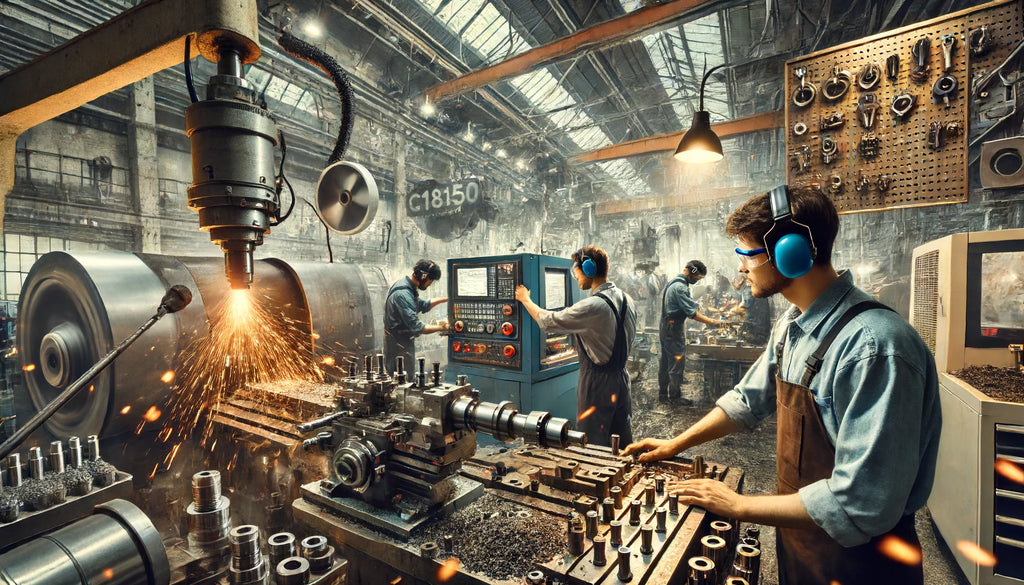The ability to machine C18150 Copper Alloy
C18150, also known as Chromium Zirconium Copper, is a high-strength copper alloy renowned for its exceptional combination of conductivity, mechanical strength, and wear resistance. This makes it an ideal material for various high-performance applications, including electrical connectors, welding electrodes, and resistance welding components. However, its machinability presents certain challenges that need to be addressed to ensure efficient and precise manufacturing.
Key Machinability Characteristics
-
Machinability Rating:
- C18150 has a machinability rating of approximately 20-30% relative to free-machining brass, which is considered the standard (100%). This lower rating indicates that C18150 is more difficult to machine than materials with higher ratings, necessitating careful planning and the right techniques.
-
Cutting Speeds:
- Due to the alloy's hardness and strength, lower cutting speeds are recommended. High cutting speeds can lead to excessive heat buildup, tool wear, and suboptimal surface finishes. A general guideline is to start at slower speeds and gradually adjust based on the tool's performance and the quality of the machined surface.
-
Tooling:
- Carbide Tools: Carbide tooling is preferred when machining C18150 due to its superior hardness and wear resistance. Carbide tools maintain their cutting edge longer and can handle the stresses associated with machining harder materials.
- High-Speed Steel (HSS) Tools: While HSS tools can be used, they tend to wear out more quickly, leading to frequent tool changes and potentially higher production costs.
-
Coolants and Lubrication:
- Effective use of coolants is crucial when machining C18150. Coolants help dissipate heat, reduce thermal expansion, and extend tool life. Water-soluble coolants or cutting oils can be used, depending on the specific machining operation and desired surface finish.
-
Tool Geometry and Coatings:
- Using tools with appropriate geometry, such as positive rake angles, can improve chip evacuation and reduce cutting forces. Additionally, coated tools, such as those with titanium nitride (TiN) or diamond-like coatings, can enhance wear resistance and prolong tool life.
-
Feed Rates and Depth of Cut:
- Optimizing feed rates and depth of cut is essential for achieving the best balance between machining efficiency and tool life. Too aggressive cuts can lead to rapid tool wear and poor surface finishes, while overly conservative cuts can result in inefficient machining processes.
Practical Tips for Machining C18150
- Initial Setup: Begin with conservative cutting parameters and gradually adjust based on tool wear and surface finish quality. Monitor the machining process closely, especially during initial runs, to identify any issues early.
- Tool Maintenance: Regular inspection and maintenance of cutting tools are necessary to ensure consistent performance. Replace worn tools promptly to avoid compromising the quality of machined parts.
- Chip Control: Effective chip control is vital to prevent damage to the workpiece and tooling. Use appropriate chip breakers and ensure efficient chip evacuation from the cutting zone.
- Surface Finish: To achieve a high-quality surface finish, consider using a finishing pass with reduced feed rates and depths of cut. This can help remove any residual tool marks and improve the overall surface integrity.
Conclusion
While machining C18150 requires attention to detail and specific strategies, the benefits of using this high-strength, high-conductivity copper alloy often outweigh the challenges. By selecting the right tooling, optimizing cutting parameters, and employing effective cooling and lubrication techniques, manufacturers can successfully machine C18150 to meet stringent performance and quality requirements.
This comprehensive understanding of C18150’s machinability can help engineers and machinists achieve better results in their applications, ensuring reliable performance and extended service life of the components made from this versatile copper alloy.



Comments (0)